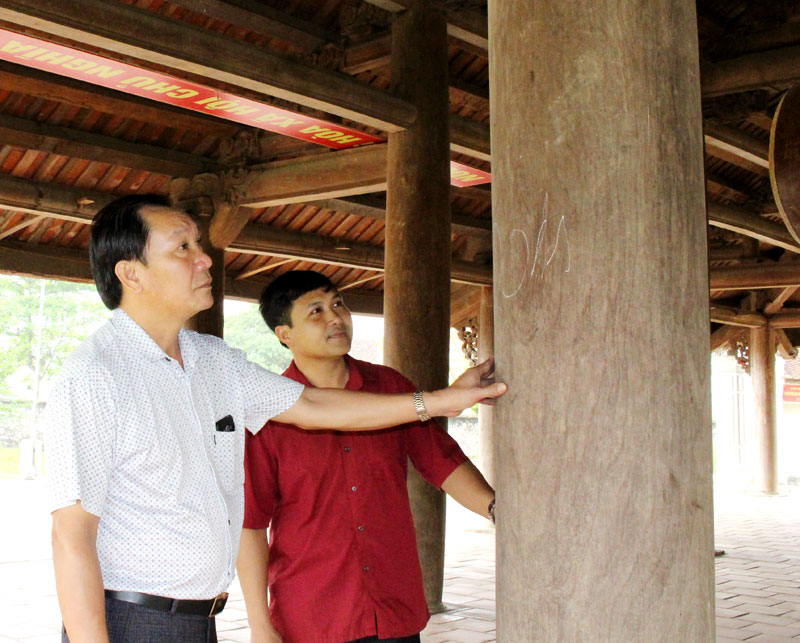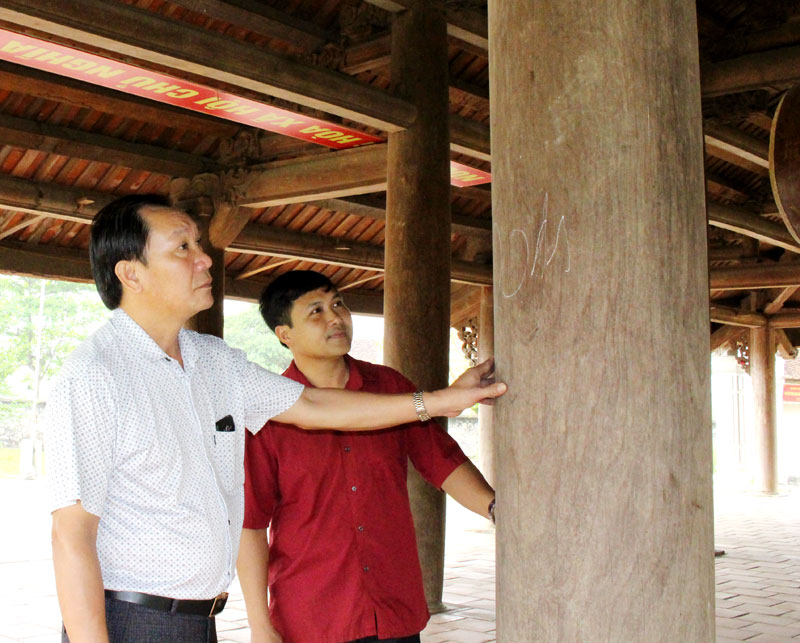
(HBO) - Yen Thuy district has a system of religious establishments such as temples and pagodas that contain many historical and cultural values associated with the unique cultural belief of the local people. They include 12 cultural and historical relics, scenic spots, three of which have been ranked as the national and 9 have been ranked as provincial ones. Recently, these relics have been invested and restored to serve the tourism development.
 The cultural staff of Phu Lai commune (Yen Thuy) is checking the items at Xam Temple for the restoration and conservation plans to develop tourism.
The cultural staff of Phu Lai commune (Yen Thuy) is checking the items at Xam Temple for the restoration and conservation plans to develop tourism.
Mr. Bui Trong Thuy, the Head of the Department of Culture and Information of Yen Thuy district says that on April 21, 2017 the People's Committee of the district issued Plan No. 41/KH-UBND on the implementation of the Tourism Development Project of Yen Thuy District to 2020 with a vision to 2030 to exploit the value of historical and cultural relics to develop tourism. The implementation of the Scheme and Plan has clearly defined the priority areas for the development of the infrastructure investment to serve tourism development.
The district has restored and renovated a number of historical and cultural relics such as Dai Bai Dinh Thuong house (Yen Tri commune) with a budget of about 900 million VND from the socialization funding and Dai Bai Dinh Phu Ve (Doan Ket commune) is currently in the process of mobilizing the socialization funding and other legal funding sources with the estimated budget of about 500 million VND.
Yen Thuy district has maintained and well organized the traditional festivals associated with the relics such as Hang Pagoda Festival, Xam Temple festival, Phu Ve Temple, Dinh Thuong, Dinh Trung, Tac Duc Pagoda and Dinh Temple, creating the special features for district’s festival tourism.
Additionally, Yen Thuy district also has actively reformed the administrative procedures, creating an attractive and open investment and business environment to attract investors to develop tourism. Currently, the district is calling Dai Viet Tourism Company to invest in spiritual tourism area of Lac Thinh commune. Lac Thinh commune consists of 2 famous relics. They are Tac Duc Pagoda and Ram Temple. This will be a great potential for tourism development in Lac Thuy district if they are well exploited.
With the effective preservation and exploitation of the value of the relics in tourism development, it has made an important contribution to promoting the tourism industry of the district. During the festival season of 2019, some famous relics of Yen Thuy district have welcomed a large number of visitors. In the first quarter, the district received 26,380 turns of visitors the revenue of 7 billion from tourism.
Located just a 20-minute drive from Hoa Binh City, Ora Hill Farmstay & Glamping Hoa Binh is a captivating new destination nestled in Mo hamlet, Bình Thanh commune, Cao Phong district. Combining farming with leisure, this tranquil retreat is perfect for those seeking balance, joy, and an immersive experience in the expansive beauty of nature.
Muong Bi - Tan Lac is renowned as one of the four famous Muong regions in Hoa Binh province. Blessed by nature with a favourable climate and stunning landscapes, Tan Lac holds great advantages for tourism development. The local tourism industry has made remarkable strides in recent times thanks to the attention and support from the local authorities and sectors.
With its strategic location, well-developed transport network, and diverse soil and climatic conditions, Hoa Binh is emerging as a must-visit destination in Vietnam's northwestern tourism corridor. The province boasts numerous attractions, including the Kim Boi hot springs (Kim Boi district), the Dau Rong cave complex (Cao Phong), the Mai Chau valley (Mai Chau), and the iconic Hoa Binh hydropower plant.
The northern mountainous province of Hoa Binh has been listed among the 71 most beautiful places to visit worldwide by the prestigious US travel magazine Condé Nast Traveller.
Hoa Binh province’s rich natural and cultural resources position it as a prime location for developing community-based tourism (CBT). In recent years, support from central and provincial policies, as well as assistance from non-governmental organisations, have encouraged local ethnic minority and mountainous communities to actively engage in the sector.



 The cultural staff of Phu Lai commune (Yen Thuy) is checking the items at Xam Temple for the restoration and conservation plans to develop tourism.
The cultural staff of Phu Lai commune (Yen Thuy) is checking the items at Xam Temple for the restoration and conservation plans to develop tourism.